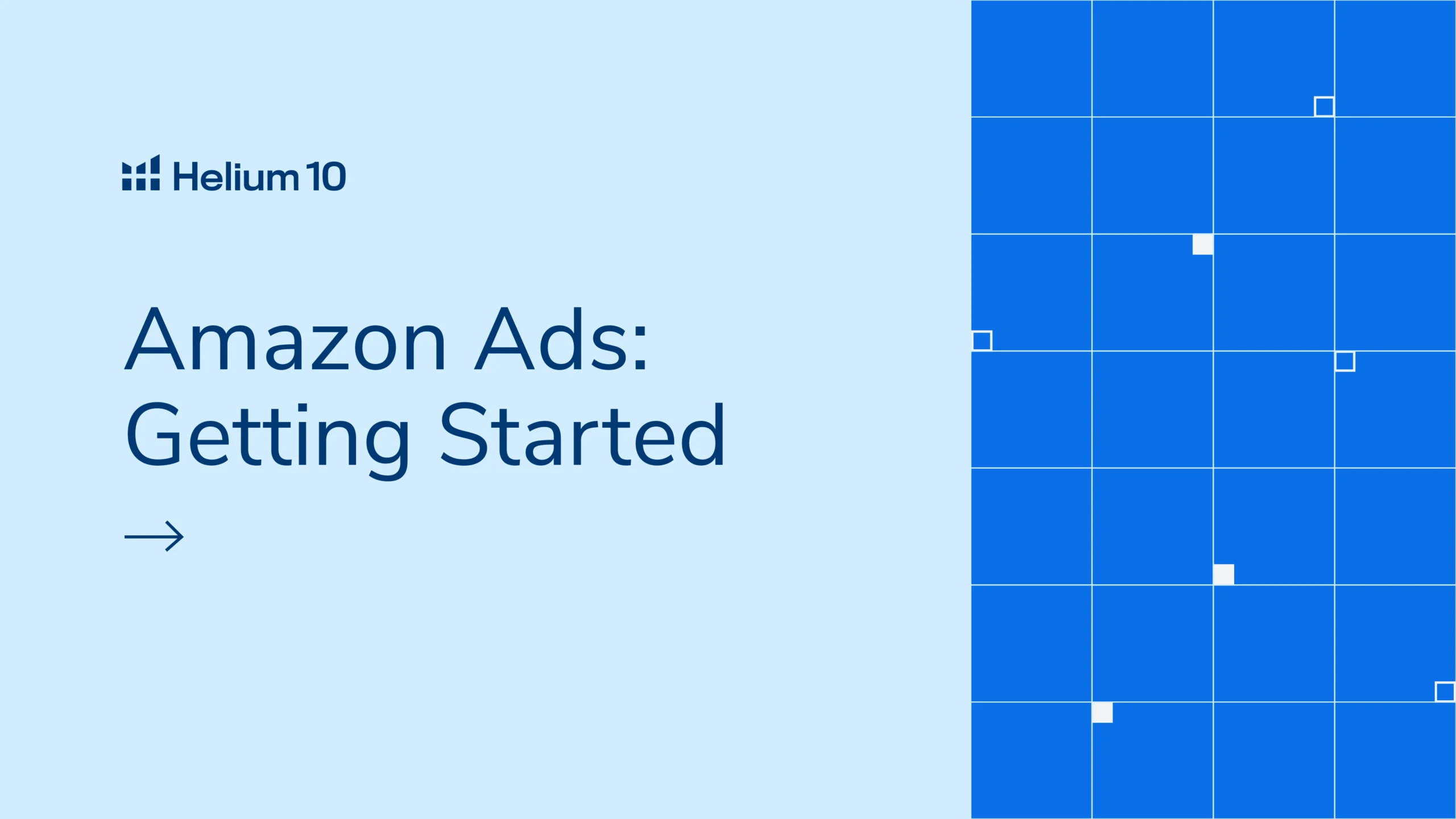
Amazon PPC Guide: What It Is & How to Get Started


Table of Contents
- Introduction
- What Is Amazon PPC?
- What Is Amazon’s PPC Platform Called?
- What Are the Different Types of Amazon PPC Ads?
- Sponsored Products
- Amazon Sponsored Brands Ads
- Amazon Sponsored Display Ads
- Stores
- Amazon DSP
- Amazon Attribution
- Amazon Posts
- Is Amazon Good for Advertising?
- How Much Does Amazon Typically Charge per Click?
- How Much Does It Typically Cost to Run an Amazon PPC Campaign?
- How Do I Know How Much to Spend on Amazon PPC?
- Is It Worth Paying for Amazon PPC?
- What Is a Good Conversion Rate for Amazon PPC?
- How Do I Set Up an Amazon PPC Campaign?
- Navigate to the Appropriate Area
- Set Up Your Campaign Budget, Duration, and Targeting
- Name Ad Group
- Select Your Products You'd Like to Run Ads For
- Set Your Campaign Bidding Strategy
- Save and Finish
- How Can I Lower My CPC for Amazon PPC?
- How Can I Increase My Amazon Ads' CTR?
- How Can I Improve My Amazon PPC Keyword Targeting?
- How Do I Edit an Existing Ad Campaign on Amazon?
- How Do I Run a Successful Ad on Amazon?
- How Should I Approach Monitoring My Amazon PPC Ads?
- Conclusion
Introduction
So you have started to sell on Amazon, but have no idea how to get eyeballs on your product. The fastest way to do that can be a couple of 3 letter words: Ads or PPC…both of which refer to Amazon PPC. Amazon has probably the most robust system for advertising of any online marketplace. Because of this, there’s lots of potential, but at the same time, it might seem overwhelming to many, so lets try to simplify the process down in this article.

Outclass Your Competitors
Achieve More Results in Less Time
Maximize your results and drive success faster with Helium 10’s full suite of Amazon and Walmart solutions.
Sign Up for FreeWhat Is Amazon PPC?
Amazon PPC is a powerful advertising platform offered by Amazon that enables sellers and businesses to promote their products to a vast and targeted audience within Amazon. Ads appear on various placements across Amazon’s website and mobile app, including search results, product detail pages, as well as external websites and apps partnered with Amazon.
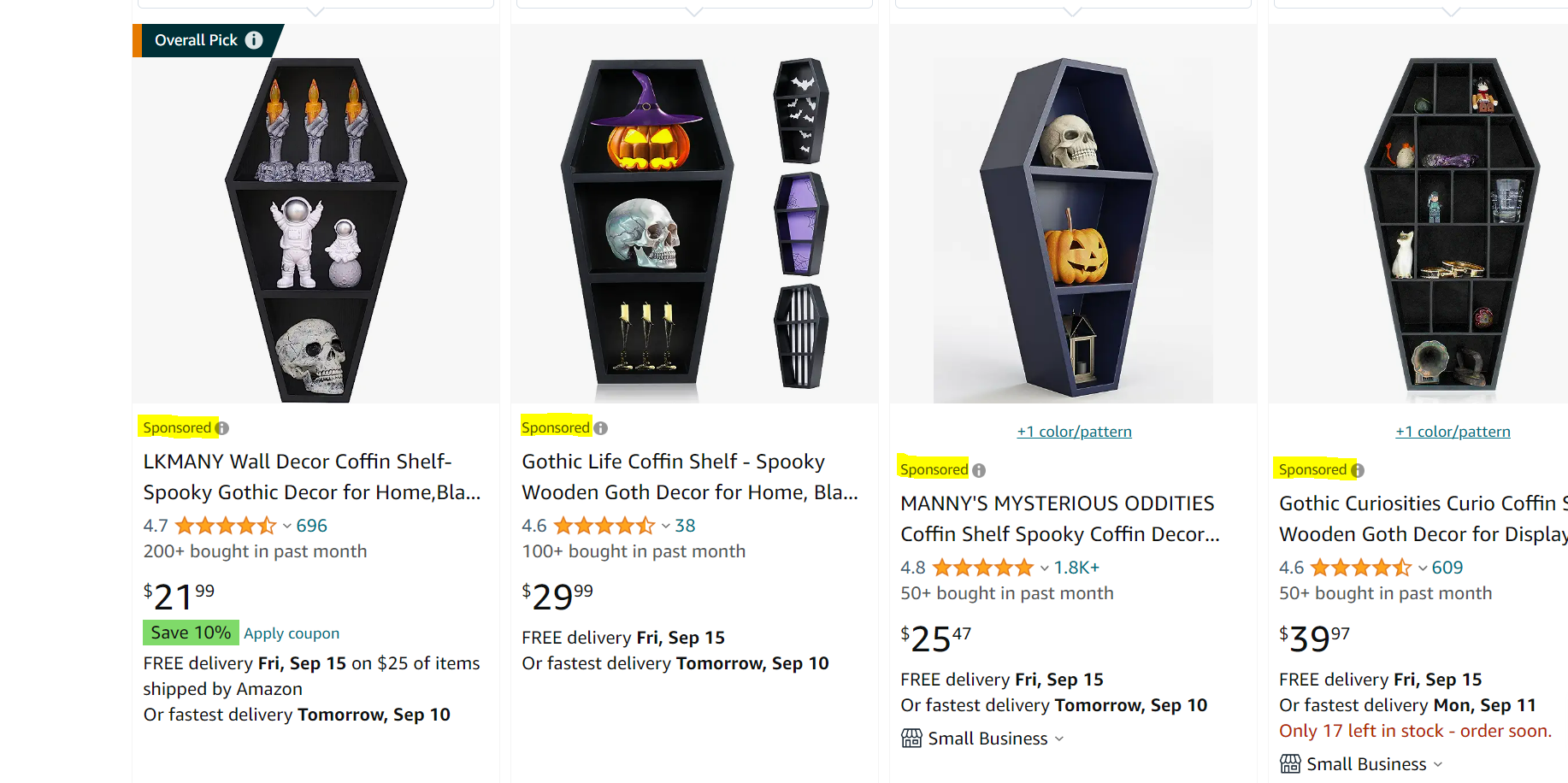
By using Amazon PPC, sellers can choose from different ad formats, each tailored to specific marketing goals. Sponsored Product Ads, for instance, allow sellers to promote individual products within search results and relevant product pages. Sponsored Brand Ads, on the other hand, enable advertisers to showcase their brand logo, tagline, and a selection of products in a single ad unit, enhancing brand visibility.
A significant advantage of Amazon PPC is their ability to reach shoppers who are actively looking for products to purchase on Amazon. These ads are displayed to users with high purchase intent, making them more likely to convert into customers. Additionally, Amazon PPC provides detailed performance metrics, allowing advertisers to track the effectiveness of their campaigns and optimize them for better results. Whether you’re a new seller or an established brand, leveraging Amazon PPC can help you enhance your product visibility, drive traffic, and increase sales on the platform.
What Is Amazon’s PPC Platform Called?
Amazon’s advertising platform is simply called “Amazon Advertising.” It’s a comprehensive and powerful suite of advertising tools and services that allows sellers, brands, and businesses to promote their products and reach a wider audience within the Amazon marketplace.
The platform offers robust targeting capabilities, allowing advertisers to reach shoppers based on factors like keywords, interests, demographics, and purchasing behavior. These targeting capabilities enhance the relevance of ads and increase the likelihood of driving conversions. Amazon Advertising’s user-friendly interface and detailed performance insights make it accessible to both novice and experienced advertisers, enabling them to effectively manage and optimize their campaigns to achieve desired outcomes.
When you couple the extensive data and reports available in Amazon Advertising with a 3rd party software analytical and automation tool like Adtomic, then you have even more power in your hands to optimize your campaigns at a very granular level.
What Are the Different Types of Amazon PPC Ads?
Sponsored Products
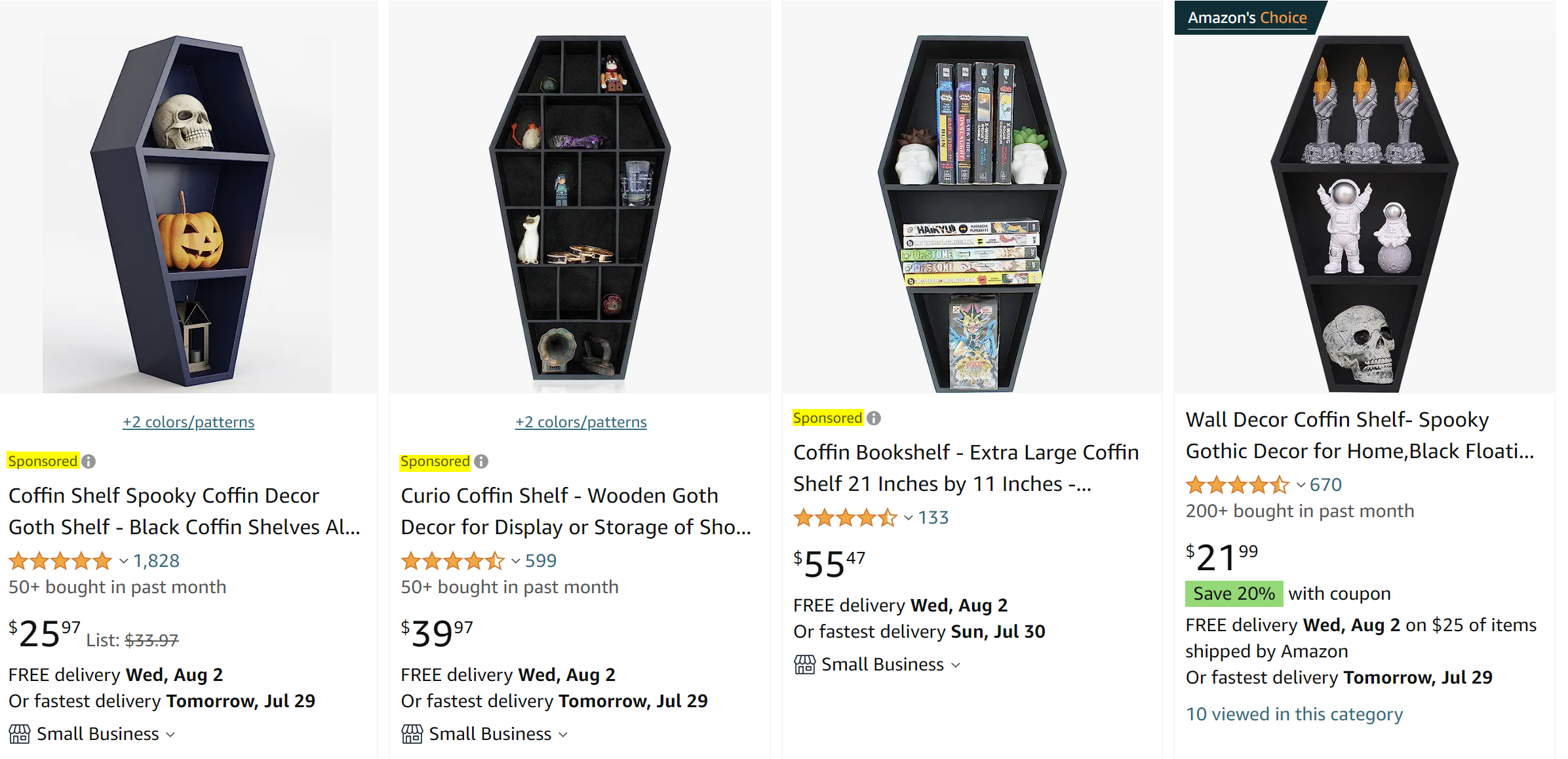
Sponsored Product Ads are the most common and widely used type of Amazon PPC ads. They appear within search results and at the bottom of a product detail page. These ads allow sellers to promote individual products and increase their visibility.
A sponsored product ad can also be considered a pay-per-click (PPC) ad, which mean that sellers pay a certain advertising fee every time a potential customer clicks on their ad. Amazon sellers can choose how much they are willing to spend on certain keywords related to their product, as well as manage their ad spend.
When shoppers search for relevant keywords, Sponsored Product Ads display targeted products, leading potential customers directly to the product’s listing. When a customer searches for a certain product, the sponsored product ads will display at the top of the search results as well as throughout each page. Sponsored Products ads are a great way to get product visibility.
When someone clicks through a sponsored products ad, and purchases the product, this can have an effect on the product’s organic ranking for the keyword searched.
Another placement for sponsored product ads are on product pages themselves as you can see below. You can target specific competitor products to try to have your product show up on their pages.

Amazon Sponsored Brands Ads
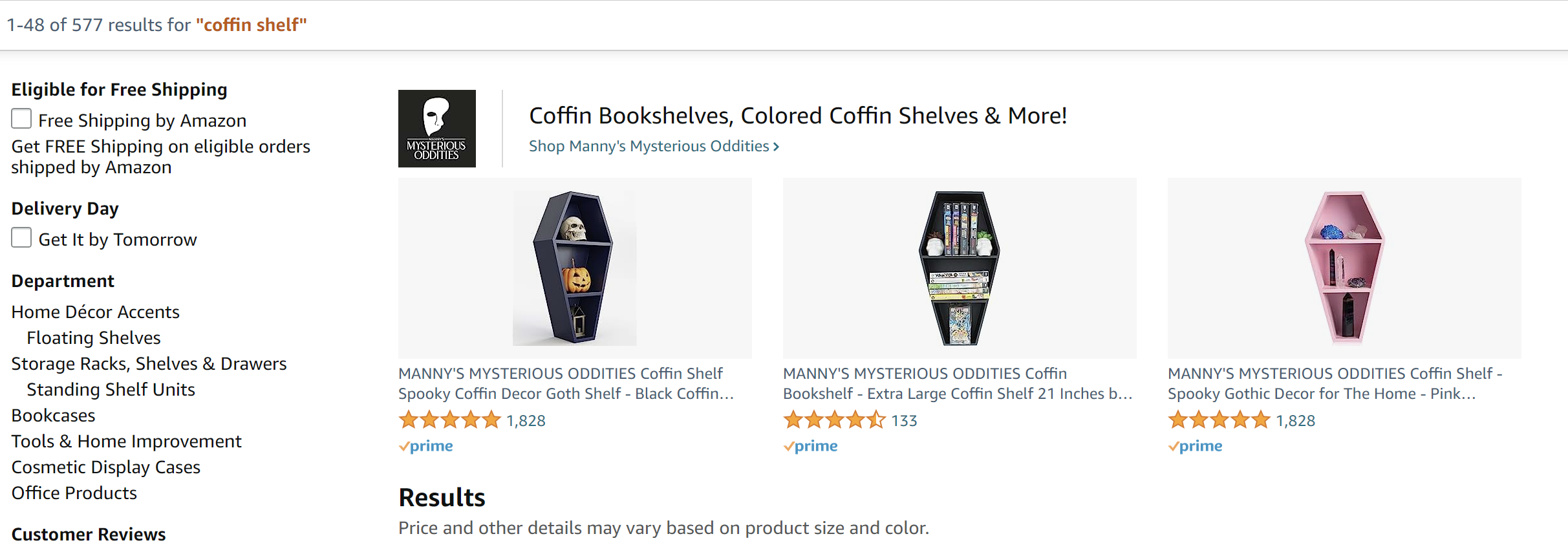
Sponsored Brand Ads (formerly known as headline search ads) are designed to boost brand visibility and awareness. These ads feature a custom headline, logo, and multiple product listings. They appear at the top of search results and help drive traffic to the seller’s brand store or a specific product page. Sponsored Brand Ads are an effective way to capture shoppers’ attention and promote a collection of products under the same brand umbrella.
Another form of sponsored brand campaigns other than headline search ads are sponsored brand video ads which usually appear half way down the search results or at the very bottom. These have a video that auto plays and a link to a product page. Many sellers use eye catching techniques in the video ads to “stop the scroll” and catch the buyer’s attention. If you want to run a sponsored brands ad, you will need to have Amazon brand registry. There is usually less competition for video ads.
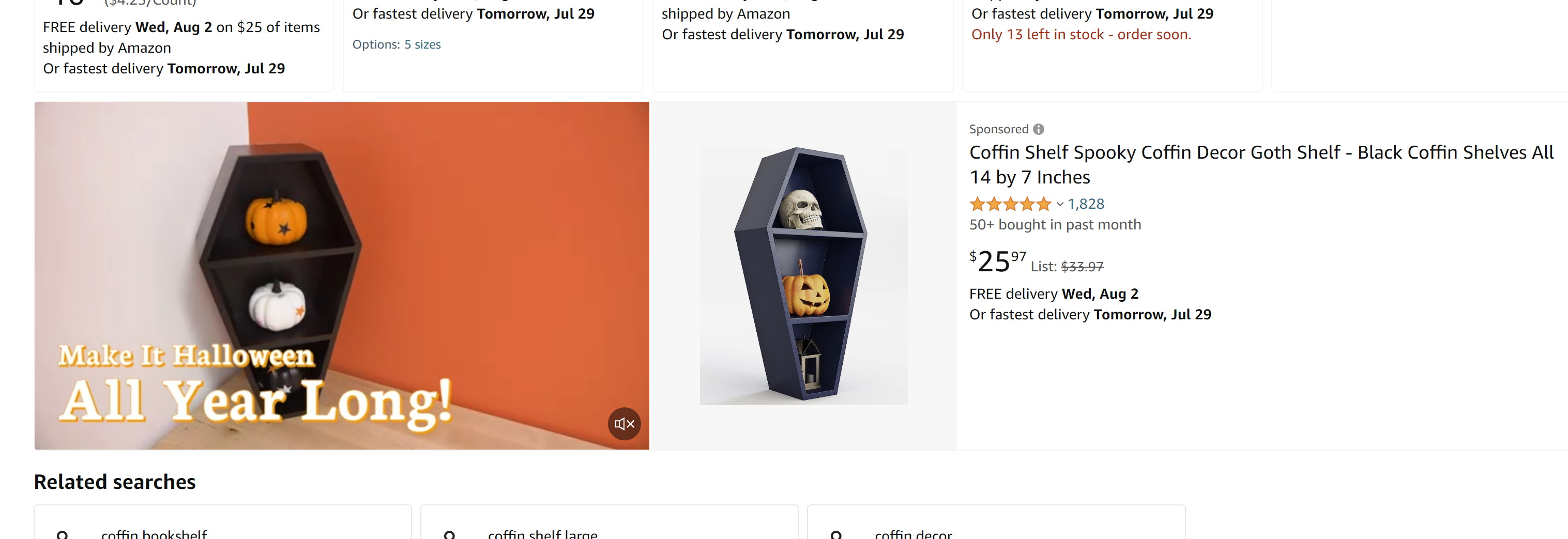
Amazon Sponsored Display Ads
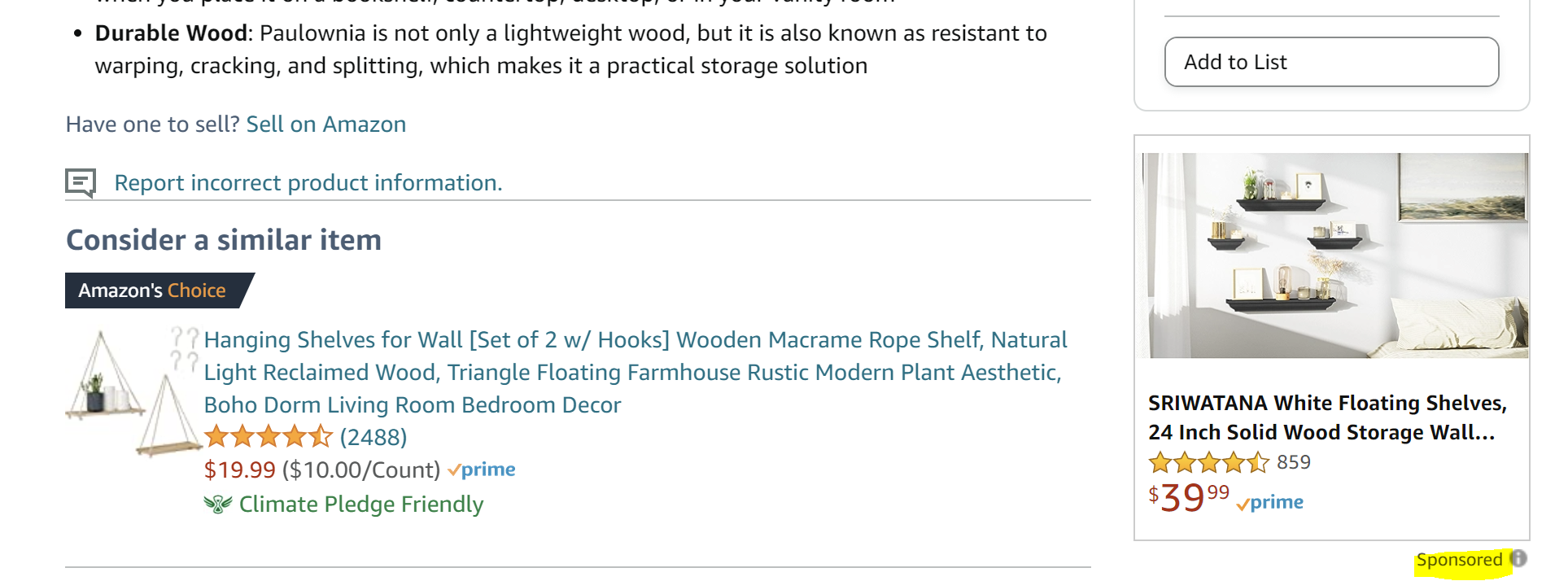
Amazon Sponsored Display Ads enable sellers to reach audiences both on and off Amazon. These ads appear on Amazon and third-party websites and apps. They help sellers retarget shoppers who have previously viewed their products and attract potential customers who fit specific demographic or interest criteria.
The most common placement of sponsored display ads is right underneath the buy box on a product detail page. There are now also the option for sponsored display video ads which also appear under the buy box.
Stores

Amazon Stores are customizable multipage microsites where sellers and vendors can showcase their brand and product offerings. They act as a brand’s storefront on Amazon, allowing advertisers to create an immersive shopping experience for potential customers.
Amazon DSP
The Amazon Demand-Side Platform (DSP) allows advertisers to programmatically buy display and video ad inventory both on and off Amazon. Advertisers can use DSP to target specific audience segments and manage their advertising campaigns through a self-service platform.
Amazon Attribution
Amazon Attribution is a tool that allows advertisers to measure the impact of their non-Amazon marketing channels on driving sales on Amazon. It provides insights into how external marketing efforts, such as search ads or social media campaigns, contribute to Amazon sales.
Amazon attribution is required if sellers want to take advantage of the “Brand Referral Bonus” where Amazon will give up to 10% of their 15% commission back to sellers who drive traffic to their stores and convert that traffic into sales. You can use the Amazon PPC platform to create these links or tools such as Portals by Helium 10.
Amazon Posts

Amazon Posts are social media style images with captions that sellers can create that do not currently have costs related to clicks, but allows sellers to drive awareness and build a following that they can re-market to inside of the Amazon platform.
Is Amazon Good for Advertising?
Amazon is an excellent platform for advertising, and is a powerhouse for businesses looking to promote their products. With Amazon’s massive customer base and extensive reach, it provides a unique opportunity for sellers and brands to showcase their offerings to a highly engaged and purchase-ready audience.
One of the key advantages of Amazon PPC is that it allows you to place your products directly in front of users who are actively searching for items to purchase. This can lead to higher conversion rates compared to traditional advertising platforms. Moreover, Amazon’s robust advertising tools and targeting options empower advertisers to refine their campaigns based on factors such as keywords, customer demographics, shopping behaviors, and more.
Additionally, Amazon’s advertising platform provides valuable data insights that can be used to optimize campaigns. Whether you’re a seasoned marketer or a new seller, Amazon’s advertising tools and resources can help you effectively tap into its vast customer base and boost your product visibility and sales.
Amazon adds more features to its PPC platform than probably any other aspect of their selling dashboard. Last year, a new service called “Stream” resulted in the ability to now see how your ads perform by hour of day. Using tools like Adtomic, you can then pause your campaigns during unprofitable times in order to maximize your ROI.
Manage Everything With Next-Level Software
Sign up now to access powerful, easy-to-use tools to help with every part of selling on Amazon and Walmart.
How Much Does Amazon Typically Charge per Click?
On average, Amazon typically charges anywhere from a few cents to a few dollars per click for sponsored ads. The cost per click (CPC) for Amazon PPC can vary widely based on several factors, including the competitiveness of your target keywords, the product category, and the overall demand for your products.
The bidding system on Amazon allows advertisers to set their own maximum bid for clicks, and the final CPC can be influenced by the bids of other advertisers competing for the same keywords. High-demand keywords or competitive product categories might result in higher CPCs, while niche products or specific long-tail keywords could have lower CPCs.
It’s important to note that while CPC is a key metric, the overall success of your advertising campaigns should also be evaluated based on conversion rates and return on investment (ROI). Monitoring your campaigns closely and adjusting your bids based on performance is crucial to achieving the desired results within your advertising budget.
Amazon has services such as “Subscribe and Save” which allows buyers to opt into an auto-order cadence. Usually you will see this in categories such as supplements, and thus sellers in these categories sometimes are willing to take a large loss on their PPC targets, because they reason that in the long run, the more opt-ins to Subscribe and Save will allow them to make their money back.
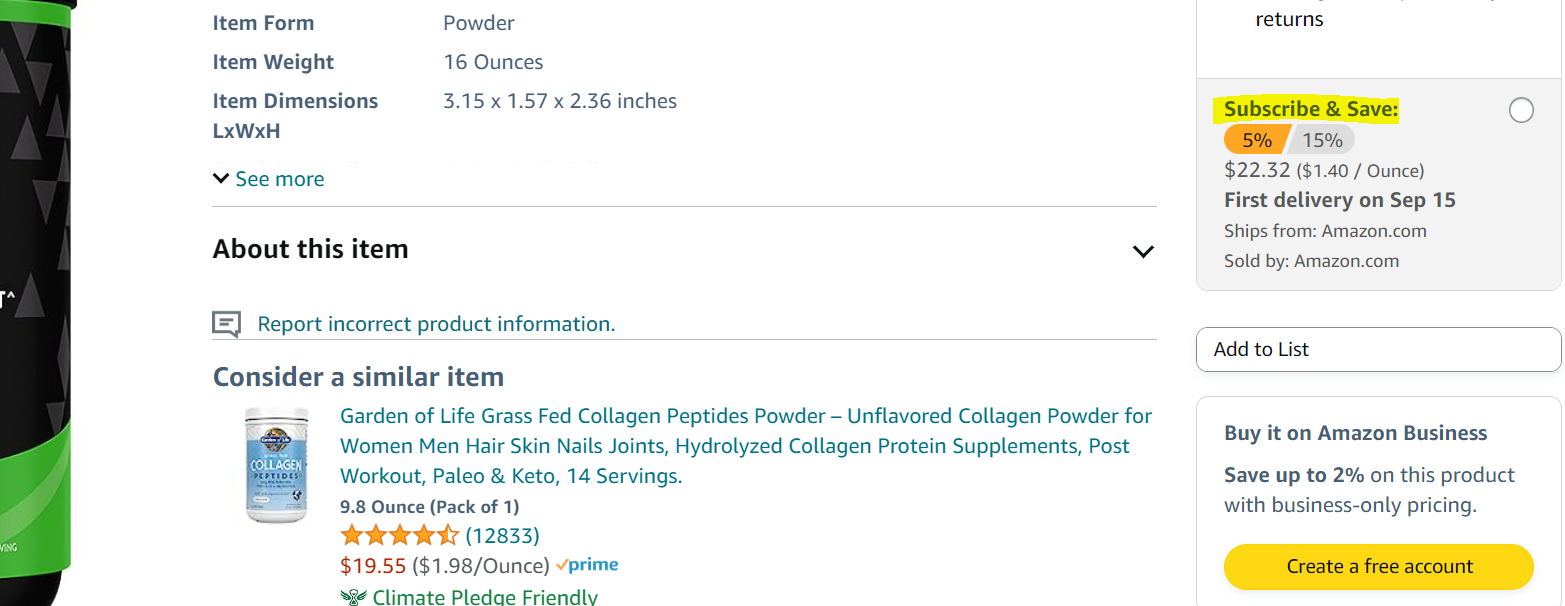
How Much Does It Typically Cost to Run an Amazon PPC Campaign?
The cost of running an Amazon PPC campaign can vary widely based on your advertising goals, product category, competition, and the duration of your campaign. Some sellers have a daily ad budget of $5-10, while other sellers may spend $50-100 per day or even much more. Amazon’s advertising platform allows you to have control over your spending, making it adaptable to businesses of all sizes and goals.
Amazon offers different types of ad formats, including Sponsored Products, Sponsored Brands, and Sponsored Display, each with its own pricing structure. Sponsored Products and Sponsored Brands ads use a cost-per-click (CPC) model, where you pay each time a shopper clicks on your ad. The CPC can range from a few cents to several dollars, depending on factors like keyword competitiveness and targeting options.
While it can be helpful to get an idea of what others typically spend on running an Amazon PPC campaign, it is important that you have an advertising budget that works for you and your business’s finances. When determining your budget, consider factors like your business goals, the size of your product catalog, and the competitive landscape.
How Do I Know How Much to Spend on Amazon PPC?
Determining the right budget for your Amazon PPC campaigns involves careful consideration of various factors to achieve a balance between visibility and return on investment. Start by defining your campaign objectives and understanding your profit margins. This will help you set a realistic budget that aligns with your business goals.
Consider your product’s category and the level of competition. Highly competitive categories might require a higher budget to gain visibility among shoppers. Evaluate the average cost-per-click (CPC) for your chosen keywords. This will give you an idea of how much you might need to bid to stay competitive.
Use newer metrics such as TACoS which stands for Total Advertising Cost of Sales, so that you can measure the effectiveness of your advertising in relation to your overall sales, including your organic sales.

It’s also beneficial to start with a test budget and monitor the performance of your campaigns closely. Amazon’s advertising platform provides data on impressions, clicks, and conversions. Analyze this data to identify which keywords, ad placements, and targeting options are generating the best results. Adjust your budget accordingly based on this data to maximize your ad spend’s effectiveness over time.
Is It Worth Paying for Amazon PPC?
If you sell on Amazon or plan to sell on Amazon, investing in Amazon PPC can be a worthwhile strategy for many sellers, but its success depends on various factors specific to your business and goals. Paid advertising on Amazon can offer several benefits, such as increased visibility, improved product discoverability, and the potential for higher sales.
When launching a new product or trying to gain a foothold in a competitive market, Amazon PPC can help you stand out from the competition and reach potential customers more effectively. Additionally, if you have a specific promotion or seasonal campaign, paid ads can provide a boost in visibility during crucial periods.
It’s essential to approach Amazon PPC with a clear strategy. Understand your target audience, choose the right ad types (Sponsored Products, Sponsored Brands, Sponsored Display, etc.), and set realistic goals. Monitor your campaigns’ performance and analyze the return on investment (ROI) to ensure that the money you’re spending on ads is generating meaningful results. By aligning your advertising efforts with your business objectives and continuously optimizing your campaigns, you can make Amazon PPC ads a valuable and profitable part of your overall marketing strategy.
If you are not monitoring your Amazon PPC campaigns regularly, they could easily get out of control, costing you money to your bottom line. Make sure you are monitoring every Amazon PPC campaign you have so that this never happens.
What Is a Good Conversion Rate for Amazon PPC?
While there’s no universally defined “good” conversion rate for Amazon PPC, a range of 10% to 15% is often considered reasonable for Sponsored Products campaigns on Amazon.
However, it’s important to note that conversion rates can significantly differ across product types and categories. High-demand categories might have lower conversion rates due to increased competition, while niche products may experience higher conversion rates.
To determine what constitutes a strong conversion rate for your specific campaign, closely monitor your performance metrics and benchmark against your competitors. Regularly analyze your conversion rates and optimize your campaigns.
Your overall conversion rates for keywords can have an effect on your organic ranking, so you should use Search Query Performance in Amazon in order to monitor that metric.
How Do I Set Up an Amazon PPC Campaign?
Knowing how to set up advertising campaigns on Amazon seller central is an essential skill for any Amazon seller. Amazon’s advertising platform allows you to advertise your products to a huge number of potential customers.
Navigate to the Appropriate Area

You will first need to log into your Amazon Seller Central account, and then once on the homepage, go to the dropdown menu on the top left corner, scroll down to Advertising, and then choose Campaign Manager. You will come to the Amazon Ads homepage, which is where you can review your campaigns, ad budgets, products that you are advertising for, as well as keyword targeting metrics.
From this campaign manager page you will be able to see any of your video ads, sponsored brands ads, sponsored display ads, sponsored products campaigns and more.
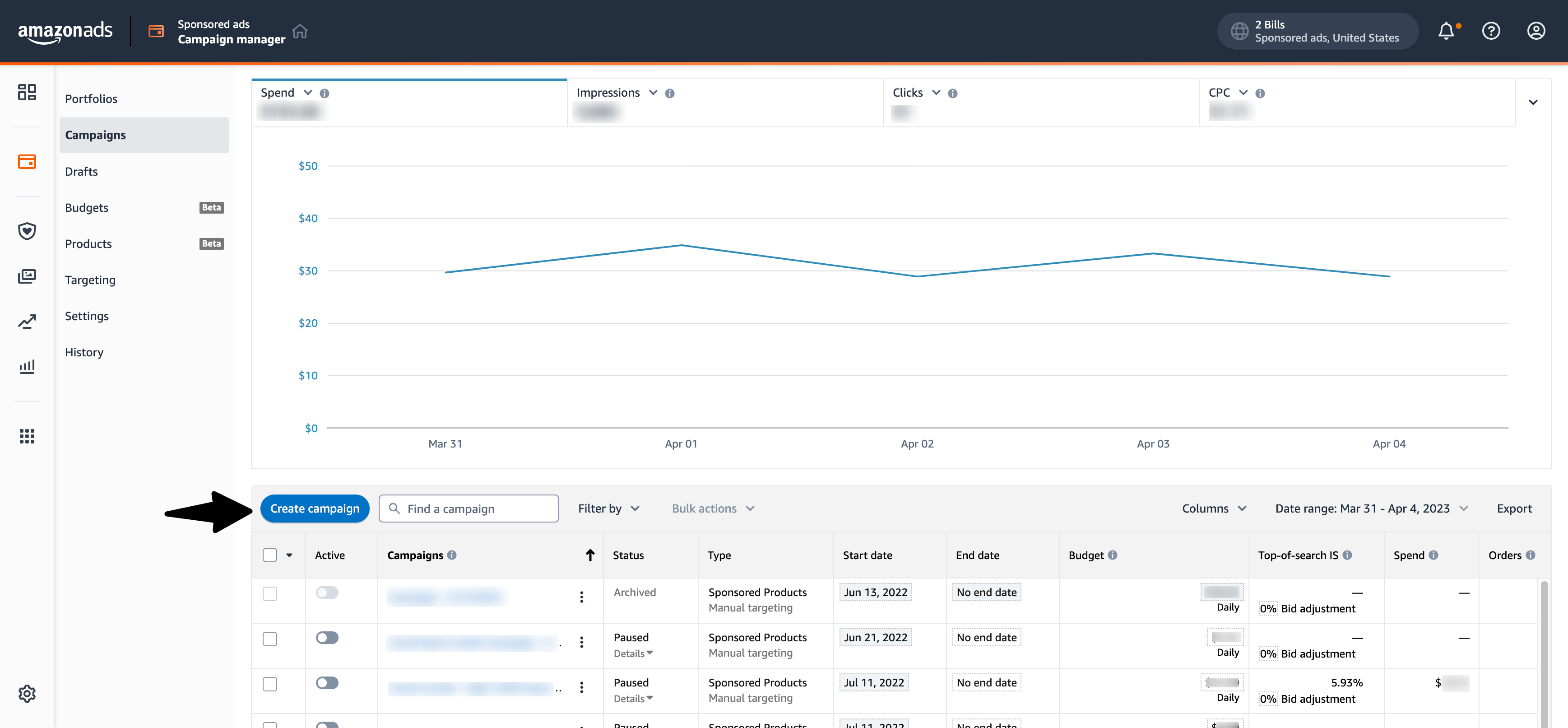
When you are ready to create an advertising campaign, you will select the blue button which says ‘Create campaign‘.
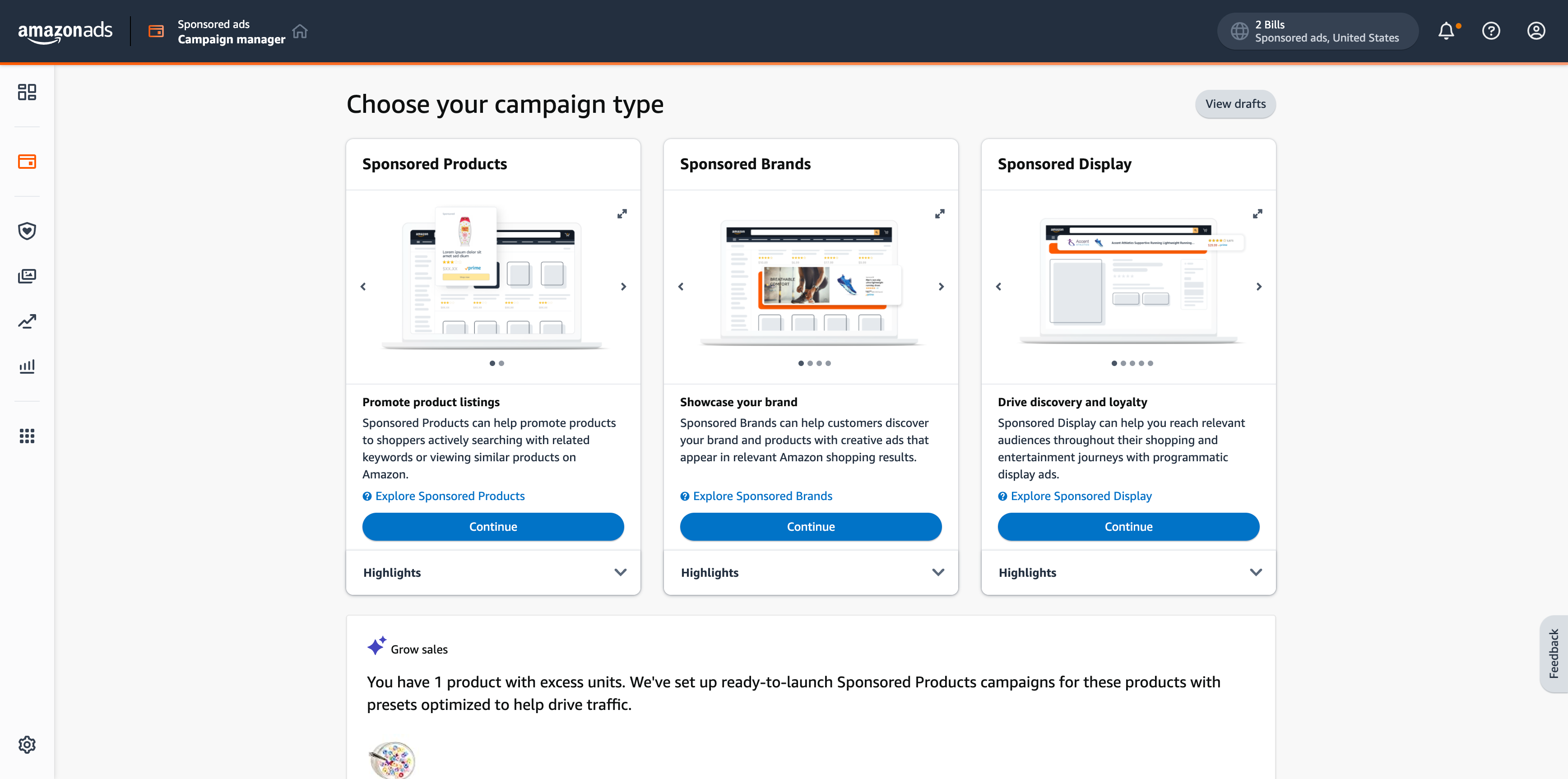
Once you click on that, you will be given the option as to what advertising campaign type you want to create. You can choose between Sponsored Product ad, Sponsored Brands ads, and Sponsored Display ads. The most common ad type will be Sponsored Products, so that is what we will use as an example for this article.
Set Up Your Campaign Budget, Duration, and Targeting

Once you have selected your ad campaign type, you will be given a variety of options and campaign settings to choose from. To set up your campaign budget and advertising campaign duration, scroll down to the ‘Settings‘ section. In this section, you can enter in a Campaign name so you can easily identify the campaign later.
Next, you can set a start and end date for the ad campaign you are creating. It is important to note that it is best for your campaign to run for at least 1 month so that you can assess how it is performing, and then make any necessary changes to it to improve your advertising metrics. Lastly, you will set a daily budget for the ad campaign. This is the amount that you are willing to spend daily on this specific ad campaign. It doesn’t necessarily mean that you will spend that budget every day, but be wary of how much budget you have for advertising.
Some sellers have a daily advertising budget of $5, and others may have $100+. Choose an amount that you are comfortable with, and be sensible as you don’t want to waste all your money on advertising if it isn’t bringing in sales. One of the main pitfalls for Amazon sellers it not having a good grasp on their advertising cost.
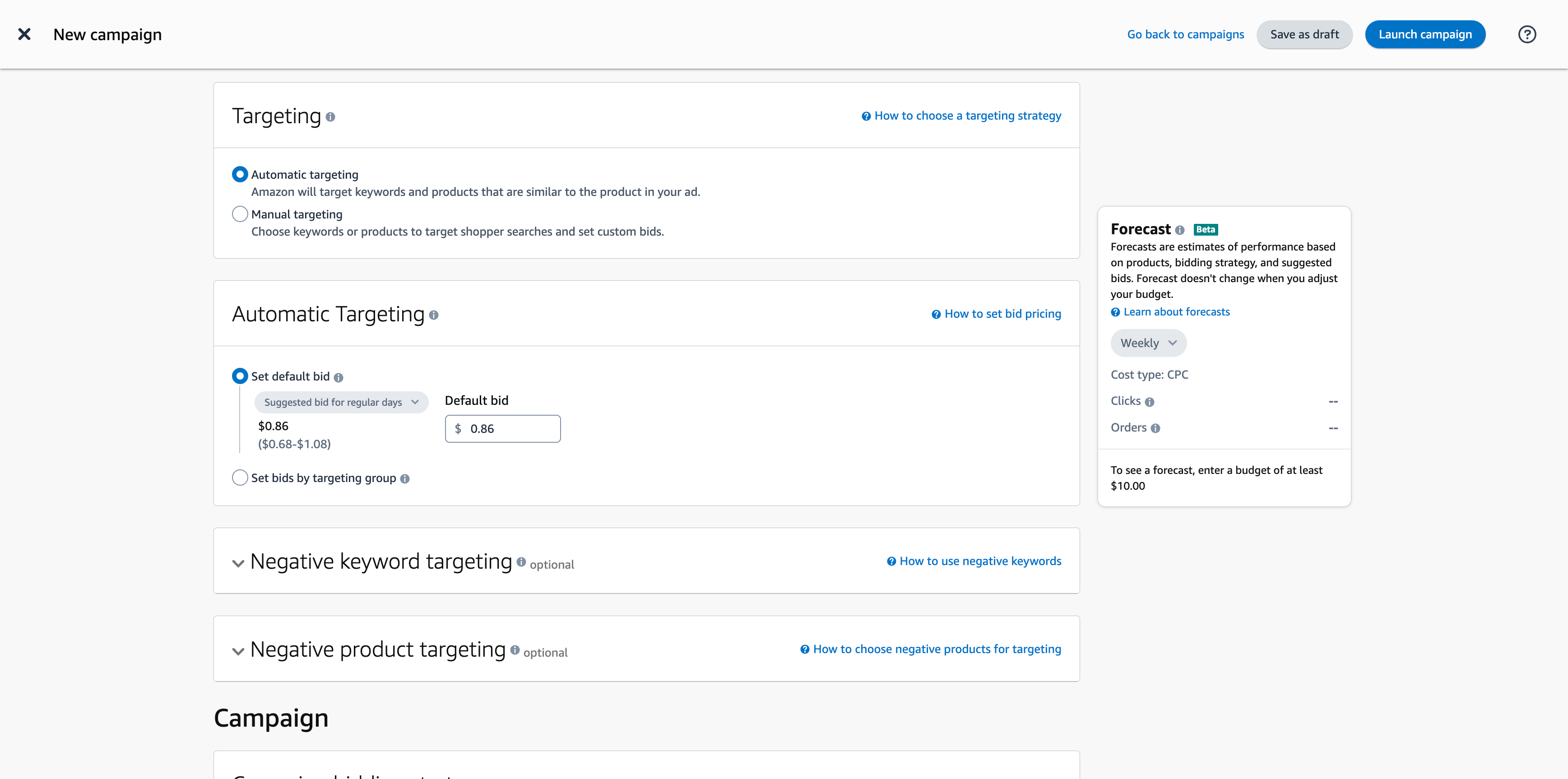
Name Ad Group
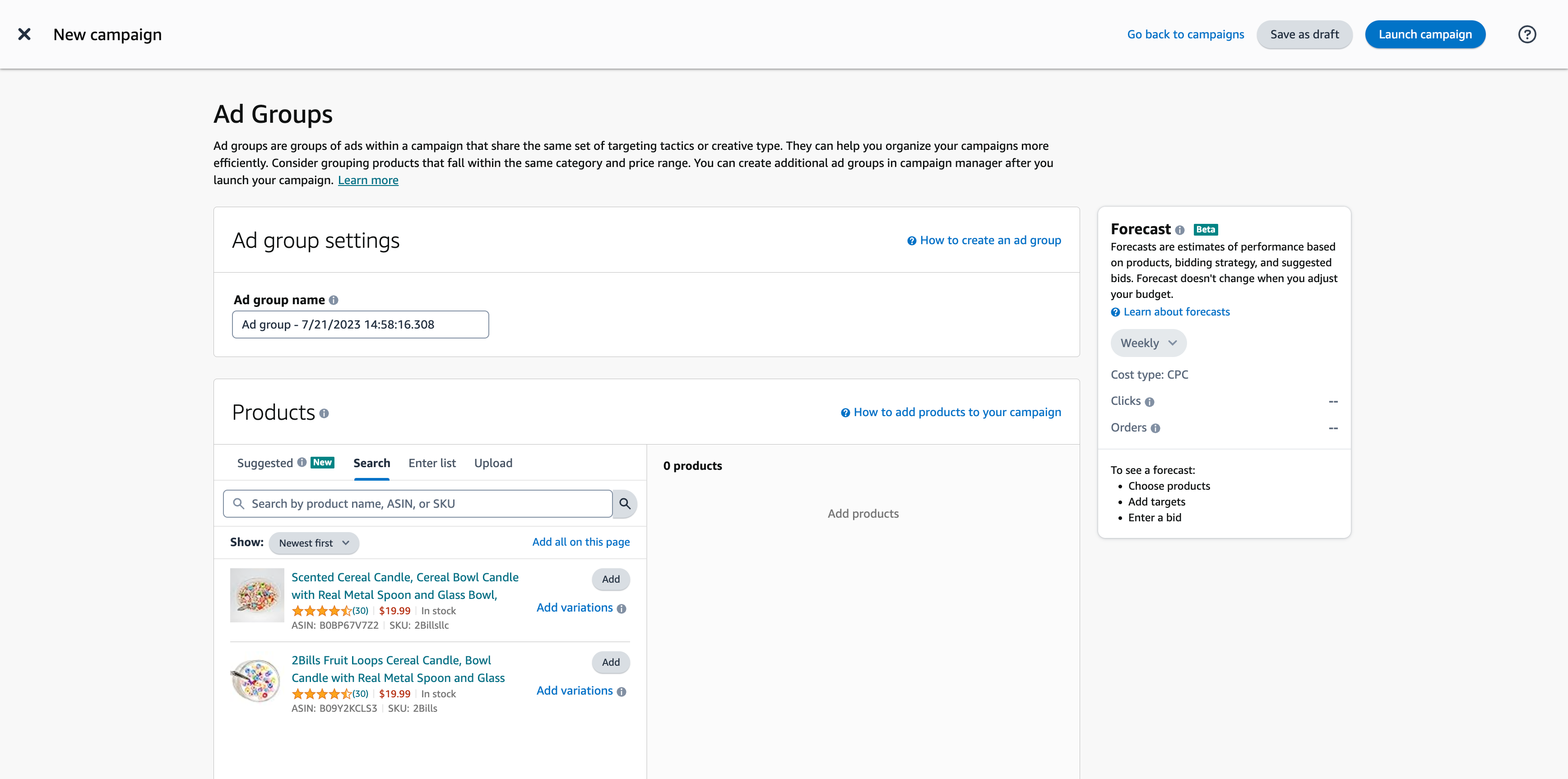
Naming your ad group is an easy step in the process, but it is an important one! During your seller journey you will create multiple ad groups, so naming them is a great way to stay organized and easily manage ads with your campaigns.
Select Your Products You’d Like to Run Ads For

Next you will select the product that you want to promote with this ad campaign.
It is typically most effective to run separate ad campaigns for each product you are selling. You could run an ad campaign for multiple products you are selling if they are in the same product category, are closely related to each other, and have a similar price point, but even in situations like that, the performance will not be as optimized as if you target them seperately.
Set Your Campaign Bidding Strategy
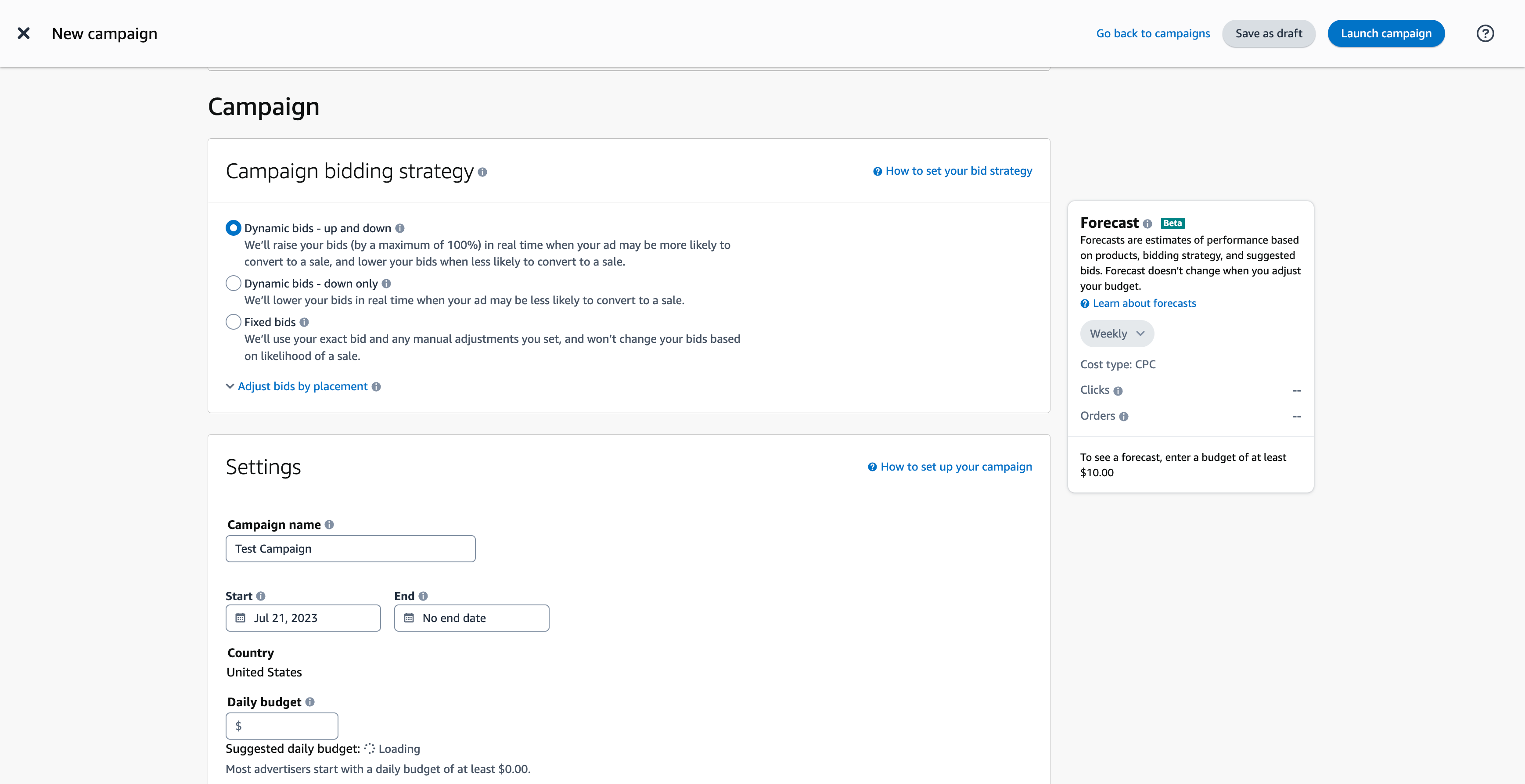
The final step, which is an important one, is deciding what your campaign bidding strategy is going to be. There are a few options to choose from, and you can always change the strategy in the future.
The first option you will see is ‘Dynamic bids – up and down’.This means that Amazon will automatically raise your bids (by a maximum of 100%) in real time when your ad may be more likely to convert to a sale, and Amazon will automatically lower your bids when less likely to convert to a sale.
The second option is ‘Dynamic bids – down only’, which means that Amazon will only lower your bids in real time when your ad may be less likely to convert to a sale.
The final option is ‘Fixed bids’ which means that you will set the exact $ amount you want to bid on a keyword, and that is the only amount you will bid. Amazon will not automatically lower or raise your bid for you.
Once you have finalized those campaign settings, you will next want to work on the ‘Targeting‘ section. You can choose Automatic or Manual targeting. If you select ‘Automatic’, Amazon will target keywords and products that are similar the product you are advertising.
If it is your first time creating an ad campaign, and you don’t have a good selection of keywords that you want to target, it may be best to try automatic targeting first. However, the better strategy would be making sure to find all of your most relevant keywords that your competitors are getting sales from by using tools such as Helium 10 Cerebro, and then starting with an exact match campaign.
After a few weeks of running an automatic targeting ad campaign, you can assess how all the keywords are performing, and then create a manual targeting campaign that only uses the keywords that performed best.
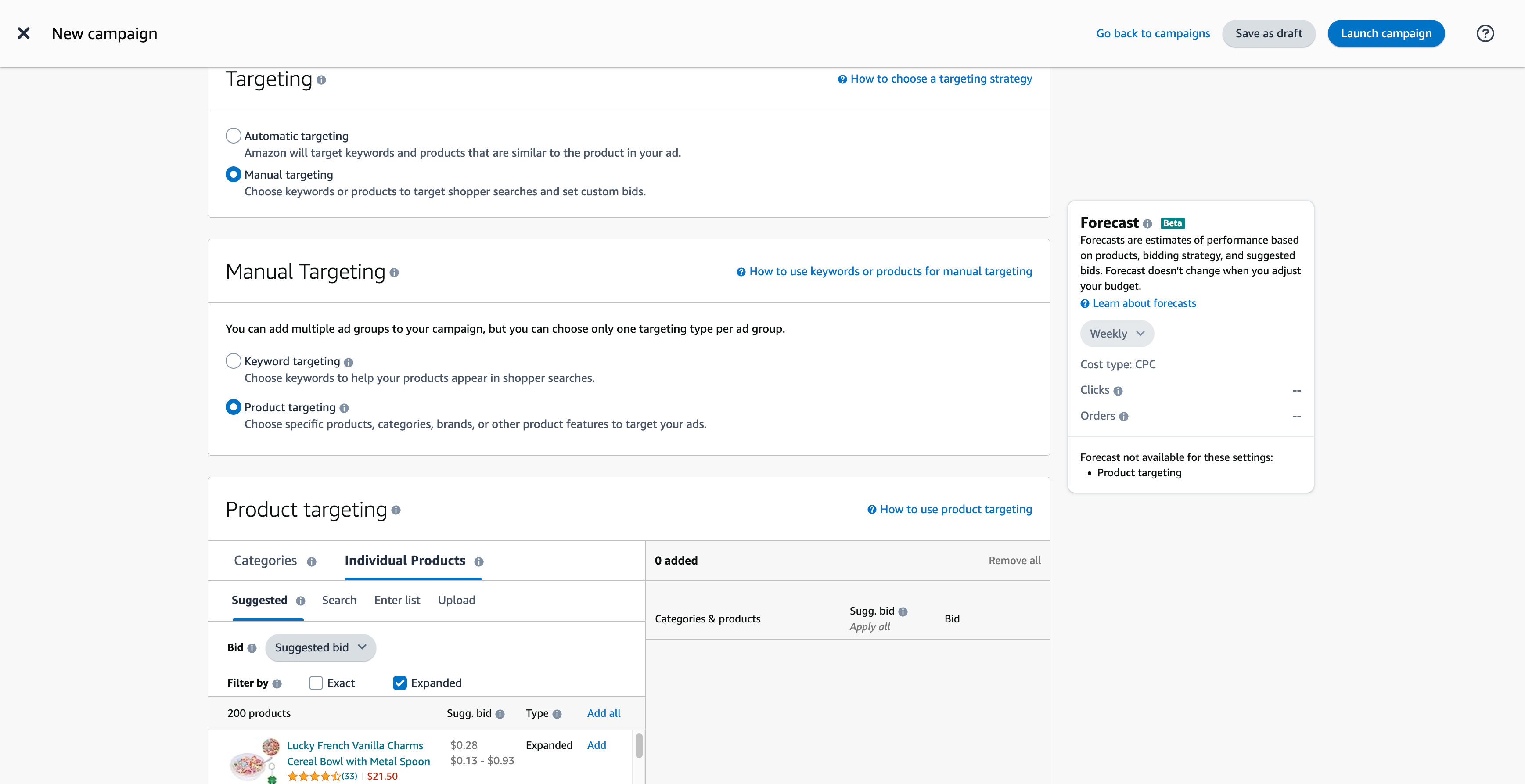
If you select ‘Manual’ targeting, you will have to manually choose keywords you want to target to help your product appear in search results. Alternatively, you can select specific products, categories, brands, or other product features to target your ads.
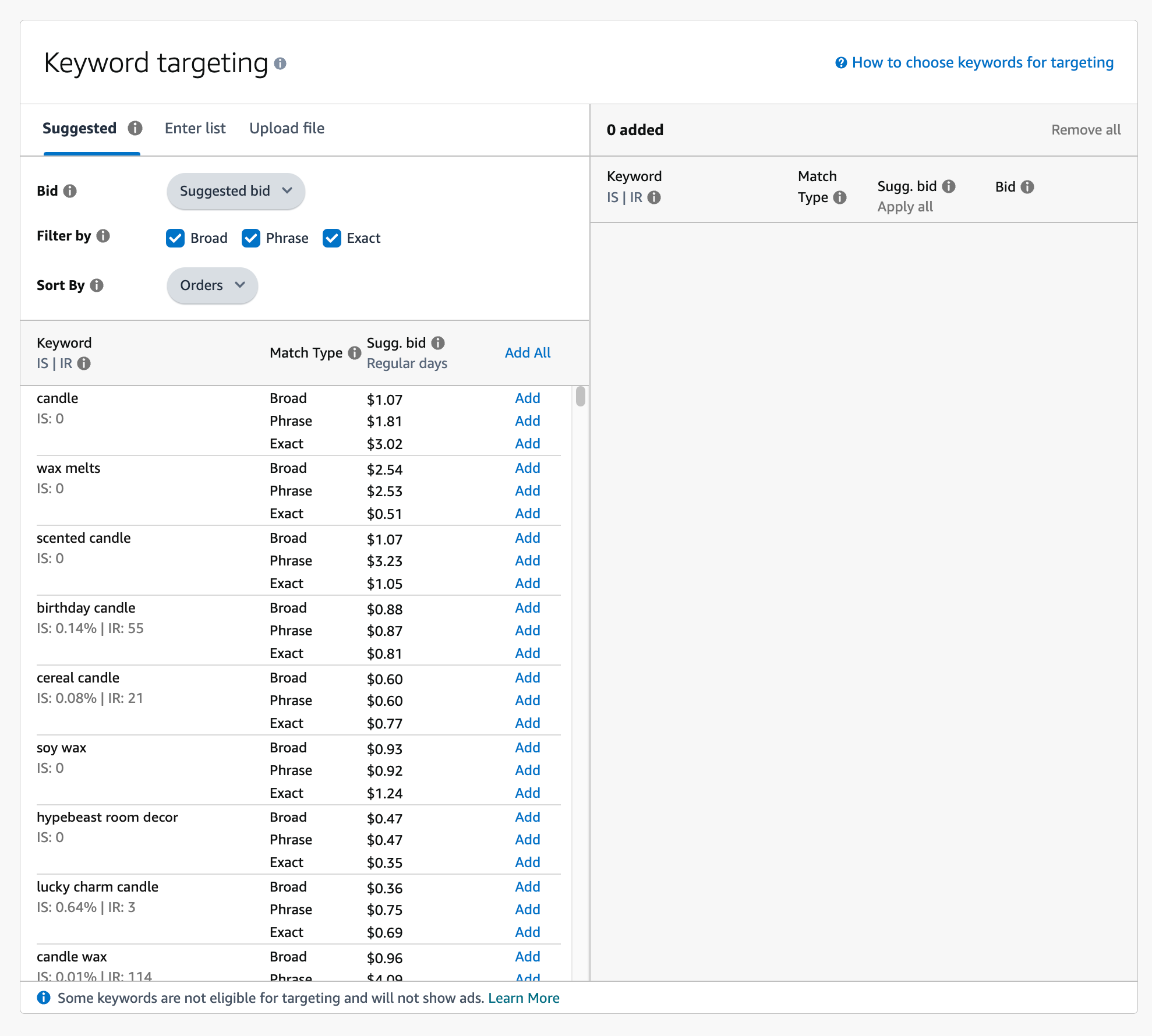
The screenshot above shows what you will first see if you select manual targeting. As you can see, Amazon provides a list of suggested keywords which you can select from. Under each keyword you will see ‘IS’ and/or ‘IR’. IS stands for Impression Share, which is the % of impressions you are getting for that specific term, relative to the total # of impressions it is generating. The higher IS, the better! IR stands for Impression Rank, which is where your Impression Share ranks against other sellers who are also bidding on that same term. The lower IR, the better!
To the right of each keyword, you will see ‘Match Type‘, broken down into Broad, Phrase, Exact.
Broad match keywords mean that your keyword will be matched to search terms that not only match your keyword, but are also related to the keyword. This can include variations, synonyms and related terms. In this example, we have candle as a keyword. A broad match could include ‘candles’, ‘3 wick candle’ ‘lighters’, ‘home decor’, and ‘aesthetic decor’.
Broad matches can be a great way to target keywords that you may not have thought of, but you must be wary that these keywords are also being bid on by other sellers who may be selling a product which is more relevant to that keyword. If you choose a broad match on a phrase such as coffin shelf, keywords such as coffin decor or black shelf might come up.
Phrase match keywords are a bit more restrictive than broad match keywords. Sticking with ‘candle’ as our keyword, examples of phrase match keywords would be ‘scented candle’, ‘soy wax candles’, ‘candle with wood wick’. As you can see, each keyword still has ‘candle’ in the phrase. In phrases such as egg tray, you can see longer tail keywords such as big egg tray, or egg tray for kitchen.
Manage Everything With Next-Level Software
Sign up now to access powerful, easy-to-use tools to help with every part of selling on Amazon and Walmart.
An ideal structure that we teach in PPC Academy for sponsored product ads for your amazon store is starting for each of your product:
- Sponsored Product Exact Match Keyword Campaign
- Sponsored Product Broad Match Keyword Campaign
- Sponsored Product Auto Campaign
- Sponsored Product ASIN Targeting Campaign
- Sponsored Display ASIN Targeting Campaign
You would then have the auto and broad campaigns “feed” newly discovered keywords into your exact match and ASIN campaigns. For example, you could set up a rule where if your auto campaign converts at least twice for the same search term, that you then move that search term to your exact match campaign so that you can hopefully get more consistent impressions on it, and build your sales history for that keyword.
If you have multiple ASINs, you can create sponsored brands campaigns to also be part of the above flow, and use the “broad” and “auto” discovery campaigns to find keywords that you can run video ads or headline search ads to.
Lastly, before adding a keyword to the list of keywords you want to target, you will see ‘Suggested Bid‘. This $ amount is calculated daily (so it is subject to change) and it is based on past bidding activity for ads similar to yours to predict bids that are more likely to win. You can choose to bid more or less, depending on how important that keyword is to you, and how much advertising budget you have to spend. These are notorious for not always being accurate, so take them with a grain of salt.

If you have added all the suggested keywords you want to bid on, or if you have already done some keyword research and know which keywords you want to bid on, then click on ‘Enter List‘. In the text box, you can manually enter in those keywords. If you have already compiled a list of keywords, you can choose to upload that list instead of having to type them out one by one. To do this, go to ‘Upload file‘, next to ‘Enter list‘. Be aware that the only accepted file formats are CSV, TSV, and XLSX.

Negative keyword targeting is optional and can seem confusing to new sellers, but it can be a powerful tool for reducing ad costs. Negative keywords are keywords you select to prevent your ads from appearing on search queries that are not relevant to your product, or are low priority. You can choose to have ‘negative exact’ or ‘negative phrase’ keywords, although negative exact is probably the best choice as you can add negative keywords without excluding you from other keywords you may not want to be excluded from.
Be careful though with doing this in the beginning. You would be surprised at how terms that you might think are irrelevant, actually would lead to sales for you. Usually its best to only negative match keywords that would cause issues that lead to returns. For example, in the past, when I sold phone cases, if the phone case we were selling was the iphone 6, we would specifically negative match keywords like iphone 6 plus, or iphone 5, because we would not want our products showing up in those results, thus potentially leading to a customer buying something that did not fit their phone!
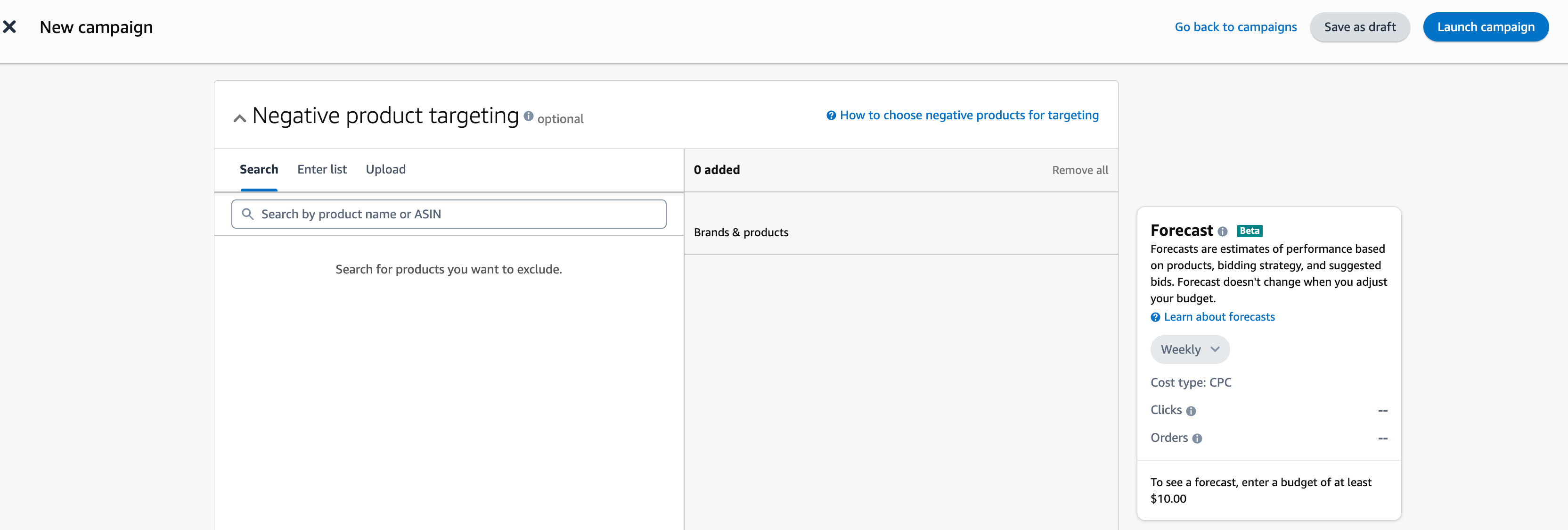
Negative product targeting is very similar to negative keyword targeting. Instead of preventing your ads from appearing on search queries based on keywords, your ads won’t appear when shoppers are looking at products that you have determined to be irrelevant to your own product.
Save and Finish
You have now successfully created an ad campaign on Amazon seller central, congratulations! Once you have launched your campaign it is important to review how it is performing, and make changes when necessary. Assessing how your ad campaign performs will help you make decisions like targeting new keywords and/or changing your bidding strategy which can help you save a lot of money and maximize your advertising budget.
An important thing to do is monitor your sponsored products ads to make sure you are not wasting money. The most common loss that sellers have is by allowing Amazon to continue to spend on targets and ad groups that are not performing well.
One potential rule you should set up is to negative match a keyword that does not seem likely to convert for a sale. For example, you could decide that if a search term gets 30 clicks without a sale, you will negative match that keyword so that Amazon will not spend your budget anymore on that keyword.
How Can I Lower My CPC for Amazon PPC?
To lower your Cost Per Click for a specific target, it is easy: Just lower your bid. If your bid is $4, and you are maxing out that bid with your CPC, but you want it lower, just lower the bid. If you are looking to lower your CPC at the campaign level, it would be a combination of multiple factors.
Of course, lowering the bids across the board would lower your campaign CPC. However if you have a target that is already low, you would not want to lower it further and potentially hurt your impressions. In this situation, its best to take a look at targets that havent gotten you ANY sales, and pause those targets, which will help you lower your overall CPC for the campaign.
How Can I Increase My Amazon Ads’ CTR?
On a specific keyword target level, there is nothing per ce you can do to increase your CTR. It is what it is. Its a representation of how customers view your product as to the keyword that they searched. Granted, if you lowered your price, or ran a coupon, of course your CTR would improve. In addition, if you are a new product without many reviews, the increase in reviews might come with a higher CTR number.
If you have low CTR on ads that have creatives tied to it such as sponsored brand ads, video ads, sponsored display ads and more, then you should adjust your creatives and test them to see if some variations give you better CTR.
How Can I Improve My Amazon PPC Keyword Targeting?
Improving your Amazon PPC keyword targeting is essential for optimizing ad performance and reaching the right audience. Start by conducting thorough keyword research to identify relevant and high-converting keywords for your products. Focus on both short-tail and long-tail keywords that shoppers are likely to use when searching for products like yours.
If you have a brand new product with no history, make sure to use tools like Cerebro in order to analyze existing competitors keyword research strategy. With that tool you can see all of the keywords they are showing up for orgnically as well as all of the keywords they are targeting in their own amazon ppc ads.
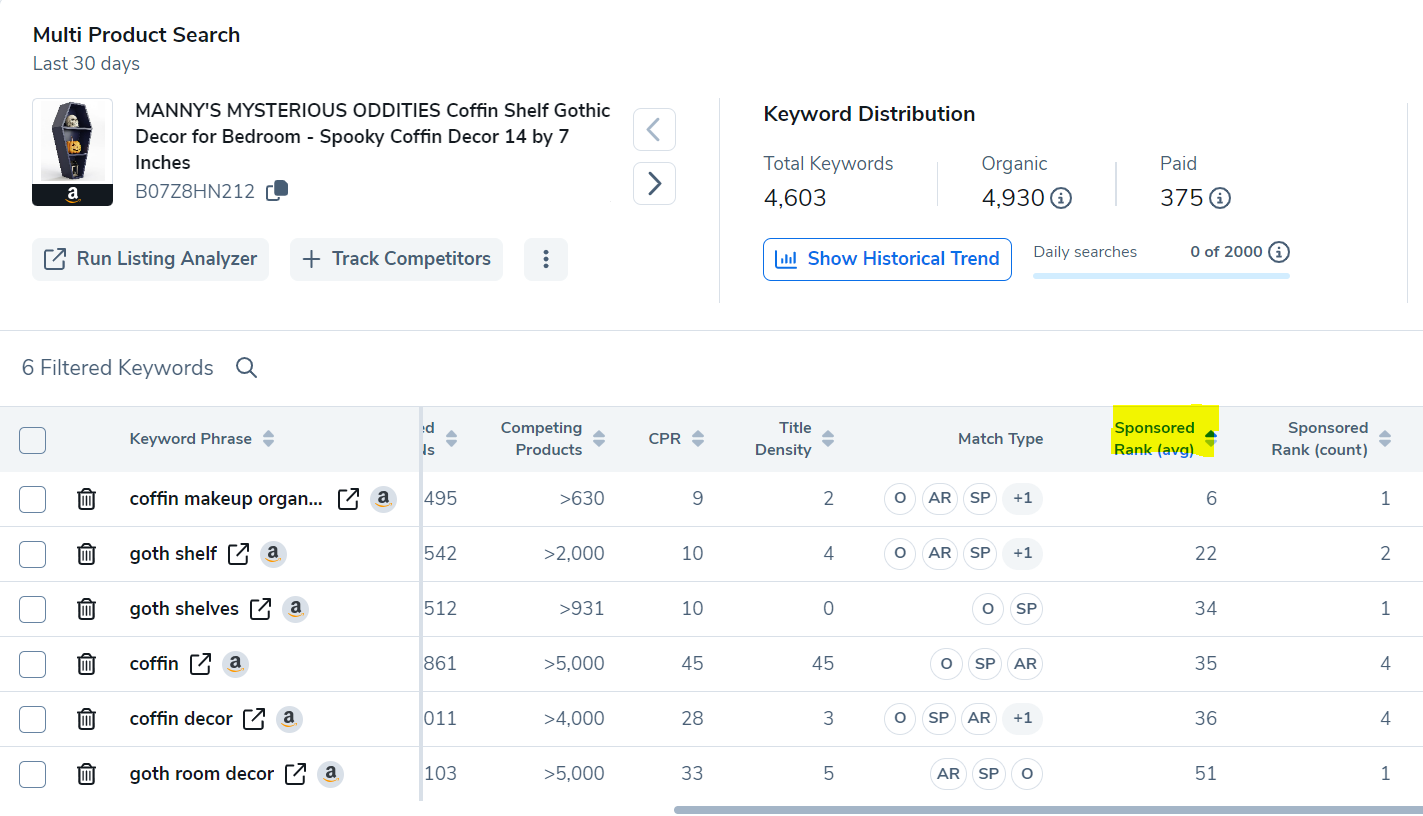
Regularly monitor and analyze your campaign’s performance metrics, such as click-through rates (CTR), conversion rates, and cost-per-click (CPC), to identify which keywords are driving the best results. Use this data to refine your targeting strategy by adjusting bids for high-performing keywords and pausing or optimizing underperforming ones.
How Do I Edit an Existing Ad Campaign on Amazon?
If you have already created an ad campaign and want to make changes to it, here is how you will do it. First, login to Seller Central and go to ‘Campaign Manager’ under ‘Advertising’ on the main menu.
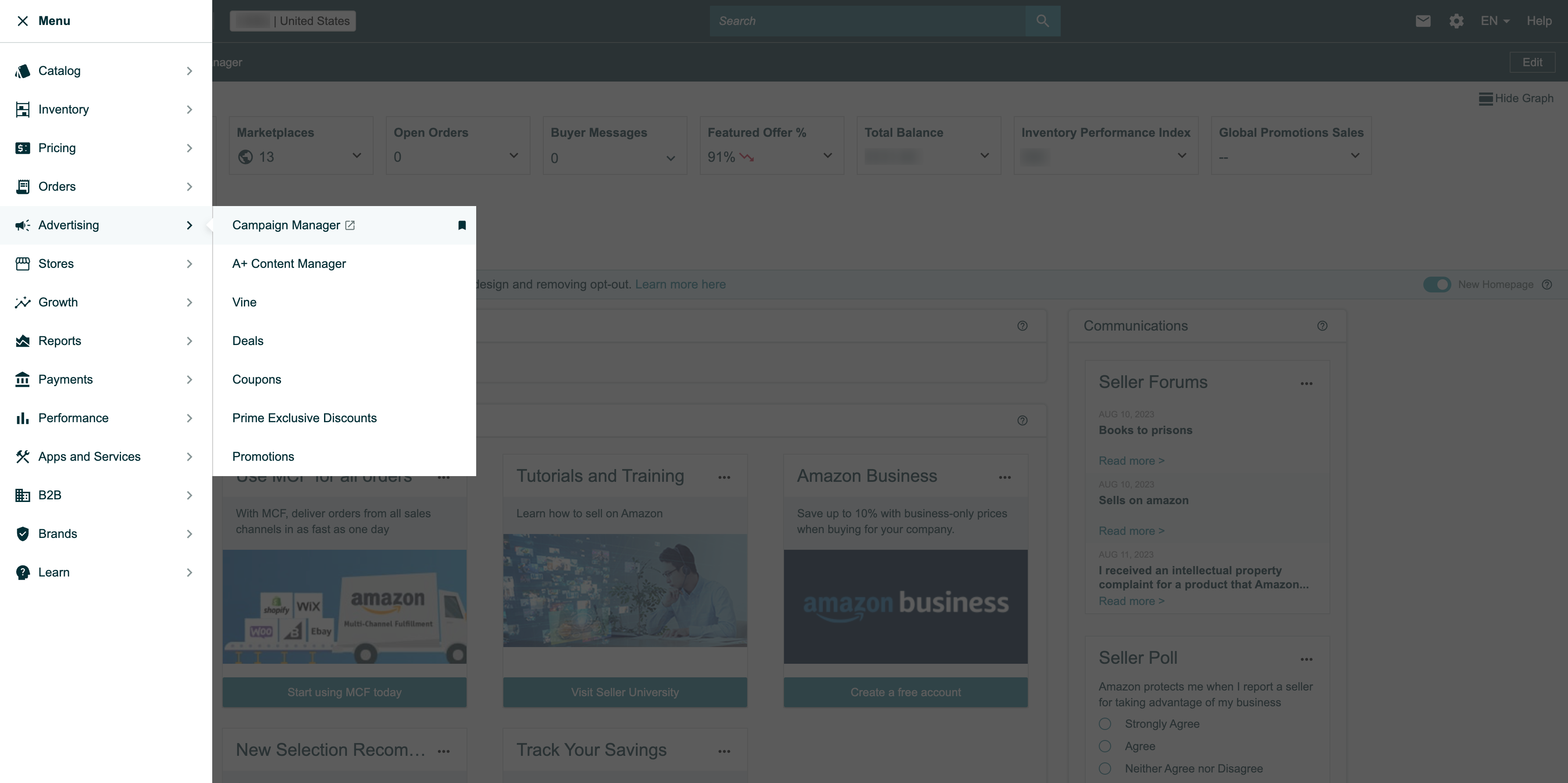
Once in ‘Campaign Manager’, near the bottom of the page you will see all your ad campaigns. Click on the campaign that you want to edit.

Once in the campaign, you can make changes such as adding/removing ad groups within the campaign, changing your placement and bidding strategy, adding/removing negative keywords, edit budget rules and campaign settings.
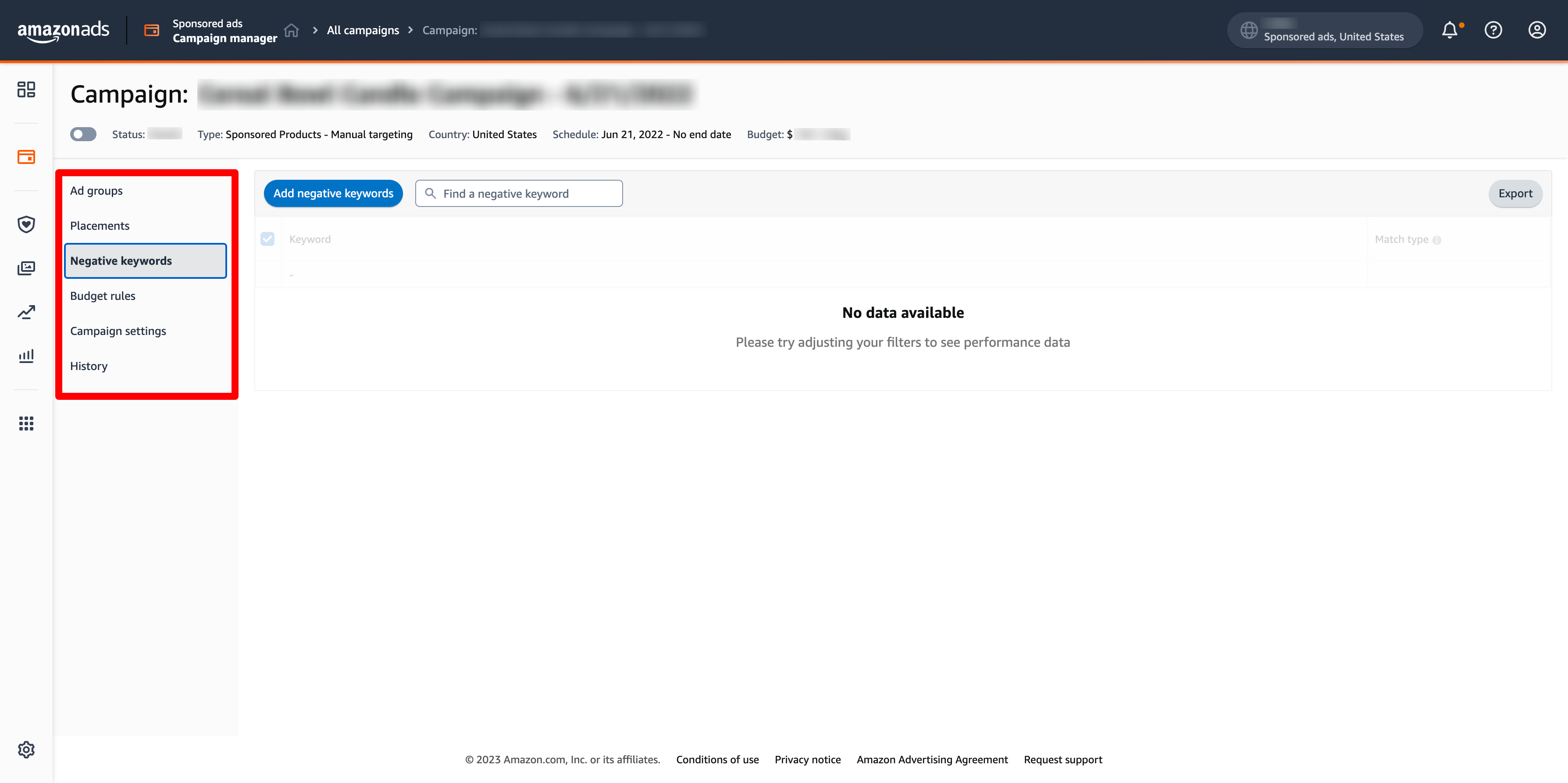
How Do I Run a Successful Ad on Amazon?
Running a successful ad campaign on Amazon requires a strategic approach that combines effective targeting, compelling ad creatives, and continuous optimization. To begin, start by conducting thorough keyword research to identify relevant and high-performing keywords that resonate with your target audience. These keywords will form the foundation of your ad campaigns, ensuring your products are displayed to the right shoppers.
Never stop experimenting and refining your strategies. Test different ad formats, ad copies, and keywords to identify what resonates most with your audience. Continuous monitoring and adjustments will help you stay competitive and ensure that your Amazon PPC campaigns drive the desired results.
Manage Everything With Next-Level Software
Sign up now to access powerful, easy-to-use tools to help with every part of selling on Amazon and Walmart.
How Should I Approach Monitoring My Amazon PPC Ads?
Monitoring your Amazon PPC ads is a crucial aspect of a successful advertising strategy. Regular and proactive monitoring allows you to gain insights into the performance of your campaigns, and helps you make informed decisions for optimizing your ads. Start by setting up a routine to review your ad metrics, such as click-through rates (CTR), conversion rates, and return on ad spend (ROAS).
Frequently check the performance of your keywords. Identify which keywords are driving the most clicks and conversions, and consider allocating more budget to them. It is equally important to monitor keywords with high spend and low conversions, as they may need to be removed from your campaigns.
Keep an eye on your ad placements as Amazon offers various ad placements, including top of search, product pages, and more. Analyzing the performance of each placement helps you understand where your ads are most effective, and where adjustments are needed.
Over time, you will start to notice trends in your ad performance and it is important to take note of them. Seasonal changes, promotions, and market trends can impact your ad effectiveness. so adjust your strategies accordingly to take advantage of opportunities or mitigate challenges.
Consistent monitoring of your Amazon PPC ads allows you to optimize your campaigns for better results. Stay attentive to the metrics, adjust strategies as needed, and remain flexible to adapt to the dynamic nature of the online marketplace.
An important thing to note is that you need to give campaigns to “breathe” before making adjustments. Remember that there is an attribution window, so what you see in real time does not tell the whole picture. For example, if someone clicks an ad today, but doesn’t buy the product, you will see the click and the cost to you for that click today. However, if they purchase the product 7 days later, it means that your performance for that day will change in retrospect.
Conclusion
Amazon PPC is a must for most Private Label Amazon sellers. It is very complicated at first glance, but when you take a step by step systematic approach to your ads, you can little by little learn to master your advertising game.
Frequently Asked Questions
Achieve More Results in Less Time
Accelerate the Growth of Your Business, Brand or Agency
Maximize your results and drive success faster with Helium 10’s full suite of Amazon and Walmart solutions.

